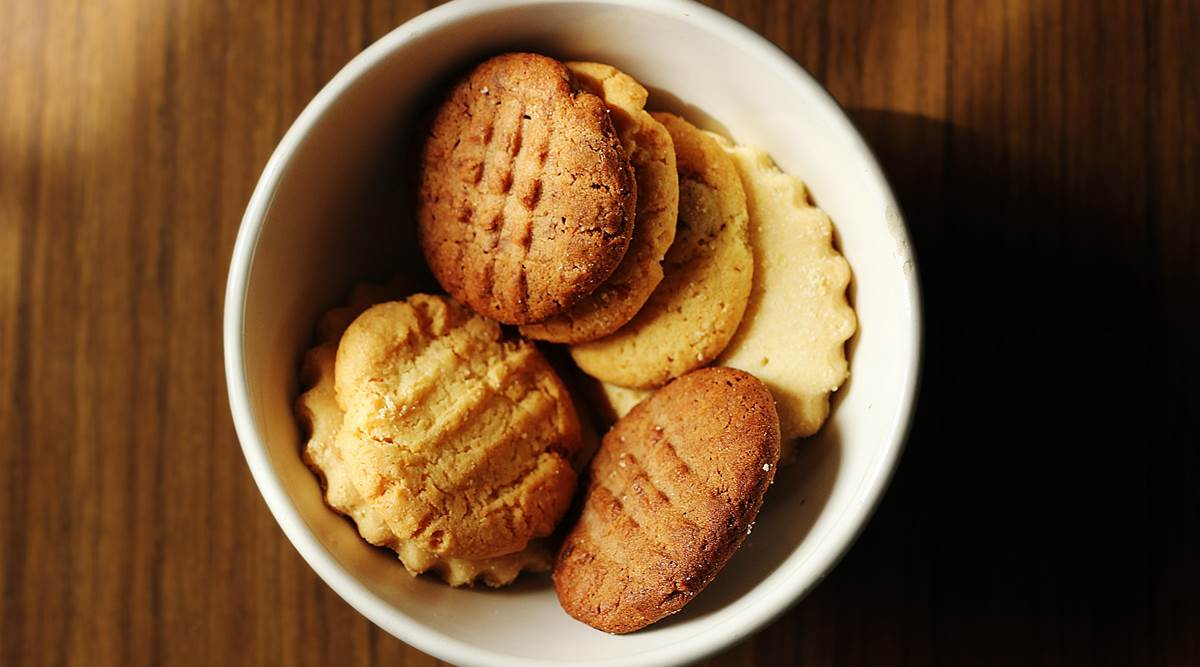 Surely the much-loved Indian version of this biscuit with no justifiable claim to the name of Shrewsbury is far superior to the ‘original’ Shrewsbury biscuit that the people of Shrewsbury treat with indifference. (Source: Pixabay)
Surely the much-loved Indian version of this biscuit with no justifiable claim to the name of Shrewsbury is far superior to the ‘original’ Shrewsbury biscuit that the people of Shrewsbury treat with indifference. (Source: Pixabay)By Mahesh Nair
Ask anyone in the UK what the word Shrewsbury means to them. The most likely answer will be that it is a quaint little English town in the county of Shropshire. Ask anyone in Pune the same question. “A biscuit”, will be the most likely response. Press them further and they may tell you that this biscuit is irresistibly delicious and buttery, guaranteed to melt in the mouth and leave you drooling for more.
So what goes into the making of this phenomenon? Not very much, from the way Mrs Asha Khodayar from Pune describes it. Calling it “a basic biscuit, just like a classic sponge cake“, she explains that Khodayar Bakery makes it because “there is always demand for a good biscuit and Shrewsbury is perfect in its simplicity and taste”. Though most recipes in the UK for Shrewsbury biscuits have eggs as an important ingredient, Mrs Khodayar reveals that the biscuits of their bakery are “eggless”.
Shrewsbury biscuits seem to come in many forms: plain, topped off with cashews or raisins, spiced, lemony, crisp, chewy. Yet they all have one thing in common. Oodles of butter.
Clearly, its uncomplicated buttery quality is the appeal of the biscuit. Talking about Shrewsbury biscuits, Ardashir Irani, owner of City Bakery, Pune, waxes lyrical about a special, scented grass that grows in the English town of Shrewsbury. This grass, he claims, imparts its scent to the milk of the cattle that graze on it, and makes the butter from this milk fragrant and delicious. Though he says that this is the reason the biscuits that use this butter are called Shrewsbury biscuits, he does not clarify whether the Shrewsbury biscuits his bakery produces contain this butter. However, Mrs Khodayar candidly confirms that their bakery uses Amul butter.
Makes sense. It is hard to believe that the Shrewsbury biscuits made and sold in Pune today contain butter imported from Shrewsbury. It is easier to assume that the butter they use is the best available locally. This butter may well be as good as or better than the ‘scented’ foreign variety, but does it justify using the word Shrewsbury to describe the biscuits it goes into? So are the Shrewsbury biscuits made in Shrewsbury more authentic and more deserving of the name?
One could argue so, especially in today’s world where Geographical Indication (GI) is fast becoming a catchword and appellations of origin act as touchstones that separate the original from the clever copy. Owing to the superiority the French ascribe to the grapes of their Champagne province, the humble English ‘bubbly’ born out of the same process is legally prevented from calling itself champagne. This is a fate that Pune’s favourite biscuit seems unlikely to meet, though one wonders how it has escaped litigation, what with “Shrewsbury” often conspicuously embossed on it.
Perhaps the answer lies in Shrewsbury’s somewhat indifferent attitude to the Shrewsbury biscuit. The town of Shrewsbury is not very far from where I live. Yet I had never heard of this biscuit until I mentioned Shrewsbury in passing to a friend in India, who told me all about the famous Shrewsbury biscuits of Pune, and wanted to know if they are a big thing in Shrewsbury itself. I had to admit I hadn’t a clue. It was a humbling moment — one which made me resolve to get the lowdown on this legend of a biscuit.
View this post on Instagram
I started my investigations with my friend Julie who hails from Shrewsbury. She told me how she had come upon the origins of this biscuit:
“I’m sure I came upon its origins by chance but I don’t remember any details, and fear they might have been underwhelming. You can buy them in delis, gourmet food stores and pop-up Christmas shops – a kind of sweet sugary biscuit with currants and a hint of lemon. I’m pretty sure I’ve never eaten one in Shrewsbury – they are the kind of thing you buy to take to friends who live elsewhere but I think they are a bit of a con and have always been a bit troubled by this.”
What I told Julie about Pune’s Shrewsbury biscuits piqued her curiosity. She posted on Facebook, requesting her Shropshire friends to share their views and experiences. The response was overwhelming and helped me confirm that Shrewsbury is not wild about the Shrewsbury biscuit.
Meanwhile, Ardashir Irani’s ‘scented grass’ story caught writer and nature lover Julie’s imagination. “Wow, this is amazing!” she wrote on Facebook. “I’ve never heard about Shrewsbury being famed for its butter and sweet-smelling grass, but you know, it probably was one day, and it brought a tear to my eye. I suppose the Welsh drovers may have grazed their cattle on the pastures there, on the way to market. I love this!”
Perhaps the discovery that this biscuit born in her hometown had such an aura of magic and mystery about it in faraway Pune touched her in a way the biscuit itself had never done.
 Despite all the hype around it, the people of today’s Shrewsbury seem to have a “Yeah, right!” attitude to the biscuit named after their town. (Source: Pixabay)
Despite all the hype around it, the people of today’s Shrewsbury seem to have a “Yeah, right!” attitude to the biscuit named after their town. (Source: Pixabay)
The forbear of the Shrewsbury Biscuit is the Shrewsbury Cake, about which records exist from as far back as the 17th century. The English playwright William Congreve mentions it in his 1700 play The Way of the World. Nearly half a century before that, a cookbook called The Compleat Cook (1658) contained a recipe for this cake. My wife Jo and I experimented with it. Instead of cakes, we got unglamorous looking biscuits. But they did melt in the mouth. The original recipe is as follows:
“Take two pound(1) of floure dryed in the Oven and weighed after it is dryed(2), then put to it one pound of Butter that must be layd an hour or two in Rose-water(3), so done poure the Water from the Butter, and put the Butter to the flowre with the yolks and whites of five Eggs, two races of Ginger(4), and three quarters of a pound of Sugar, a little salt, grate your spice, and it well be the better, knead all these together till you may rowle the past, then roule it forth with the top of a bowle, then prick them with a pin made of wood, or if you have a comb that hath not been used, that will do them quickly, and is best to that purpose, so bake them upon Pye plates, but not too much in the Oven, for the heat of the Plates will dry them very much after they come forth of the Oven, you may cut them without the bowles of what bignesse or what fashion you please(5).
- 1 pound = 453 gms
- We did not bother with this, having found our wheat flour bone dry in hermetically sealed packaging
- We had no rose water, so we improvised with two tablespoons of sherry mixed into the butter
- Having never met a ‘race of ginger’ in our lives, we took a chance with a quarter teaspoon of grated ginger
- Instead of pie plates, we used an oven tray, and made little balls out of the mixture, which we then flattened with a fork into biscuit shapes roughly 1cm thick. Since the recipe mentioned no oven temperature or cooking time, we decided that 11 minutes at 170°C should do the trick. It did.
It is not clear when the cake became a biscuit, but an interesting reference is made to the Shrewsbury Cake in the poem, ‘Bloudie Jacke of Shrewsberrie’ in ‘The Ingoldsby Legends’ by The Rev. Richard H. Barham, who wrote Gothic horror stories and poetry in the 19th century under the pseudonym of Thomas Ingoldsby. The villain of this poem, Bloudie Jacke, murders his brides on the wedding night, severs off their fingers with the wedding ring on them, and stores them in a drawer. Jacke’s last victim’s little sister Mary-Anne escapes by giving Jacke’s guard dog a Shrewsbury Cake. The fact that this cake was made by Pailin, the “Prince of cake-compounders’ appears in the notes of the poem, which was based on an old Shropshire folk tale. Though there is no proof of the historical accuracy of these accounts, those who market the Shrewsbury biscuit these days rely heavily on these myths – or truths – for their branding. Quoting on a plaque Barham’s words about Pailin – “the mouth liquifies at thy very name” – a shop in Shrewsbury claims that they are located where Pailin once baked his cakes!
ALSO READ | When Did the cookie crumble?
Yet despite all the hype around it, the people of today’s Shrewsbury seem to have a “Yeah, right!” attitude to the biscuit named after their town. Most appear to think of this biscuit as an overpriced and not particularly appetising commodity that only the tourists who come to Shrewsbury buy as a souvenir gift for friends and family. One mentioned enjoying Shrewsbury biscuits while living in Pune, and another remembered seeing these in Pune and bringing some back for their family in Shrewsbury. A few have not even tasted this biscuit. Some remember it from childhood, with no memory of the taste being anything to write home about. In short, Shrewsbury appears underwhelmed by its biscuit. Unlike the Dorset Knob, the Cornish Pasty, the Eccles Cake, the Yorkshire Pudding and so many other foods that have done their places of origin proud, the biscuit has not put its birthplace on any culinary map of the UK.
In contrast, the adulation Pune’s Shrewsbury biscuit basks in is evident from the saga of the Kayani Bakery shutdown in 2017, which was allegedly because of license renewal issues. The faithful customers of Kayani raised a hue and cry about their favourite biscuit being no longer available: they signed petitions, lobbied on social media, got the press involved and finally got their way.
Is this lionisation of the Indian Shrewsbury biscuit at least in part due to India’s Raj nostalgia? Possibly. But surely it is also the baby that India did not throw away with the bathwater of British imperialism. Surely the much-loved Indian version of this biscuit with no justifiable claim to the name of Shrewsbury is far superior to the ‘original’ Shrewsbury biscuit that the people of Shrewsbury treat with indifference.
For more lifestyle news, follow us: Twitter: lifestyle_ie | Facebook: IE Lifestyle | Instagram: ie_lifestyle
📣 The Indian Express is now on Telegram. Click here to join our channel (@indianexpress) and stay updated with the latest headlines
For all the latest Lifestyle News, download Indian Express App.